While doing research for my God of War series I had a little bit of extra material that didn’t quite fit in with the other chapters. I’d like to share this final bit of concept work that never made it into the finished game, and perhaps give it some context. I’ve mentioned earlier on the blog that the
Piraeus Lion was the best sub-boss in the series. There is an entire stage, and sub-plot in the Ghost of Sparta featuring Kratos stalking an escaped prisoner called the Dissenter. The player does this in the underground prison of Sparta. The atmosphere of the stage, level design, mood, and sound effects all lead up to a battle with the gigantic lion. It resonated with me more than any other sub-boss encounter in the franchise. The fact that they didn’t reuse the lion in any other part of the story made it mean more than any battle with a minotaur, or cyclops. I believe that the inspiration for the Piraeus Lion was due to another encounter that was planned in the previous game, the Chains of Olympus.
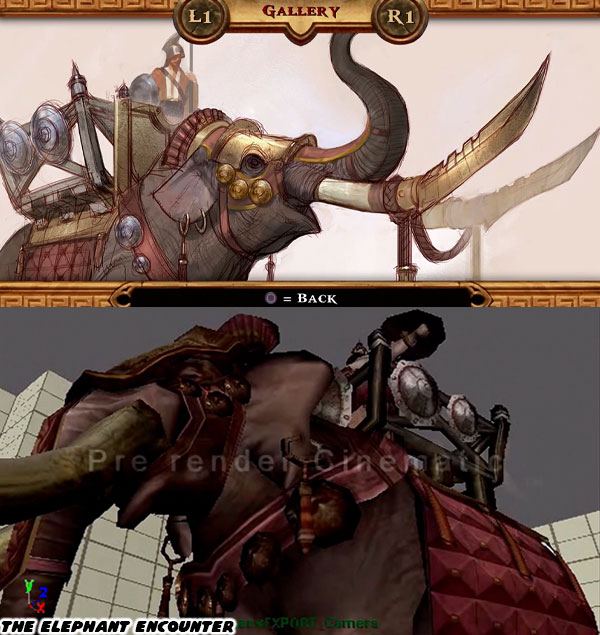
In the concept art for the game there is a war elephant. It is probably one of the best unused enemy designs in the series. It was so amazing that the studio even created a 3D model, and rendered a few scenes as to where this encounter would have happened. At the start of the game Kratos is with his Spartan army helping the Athenians defend Attica from a Persian invasion. This was an actual encounter from history. It was made fantastic with the inclusion of the Basilisk, an enormous fire-breathing reptile that was unleashed by the Persians. Kratos gives the monster chase, fights on the beach, and makes his way to the city gates. He breaks through the armored door by using a battering ram, and turns the corner. This is where he was supposed to see the war elephant for the first time, and its rider, a Persian King. The high walls of the city gate, and bridge make for a constricted fighting platform. Just as the locked cells in the jails of Sparta raised the stakes for the lion reveal.
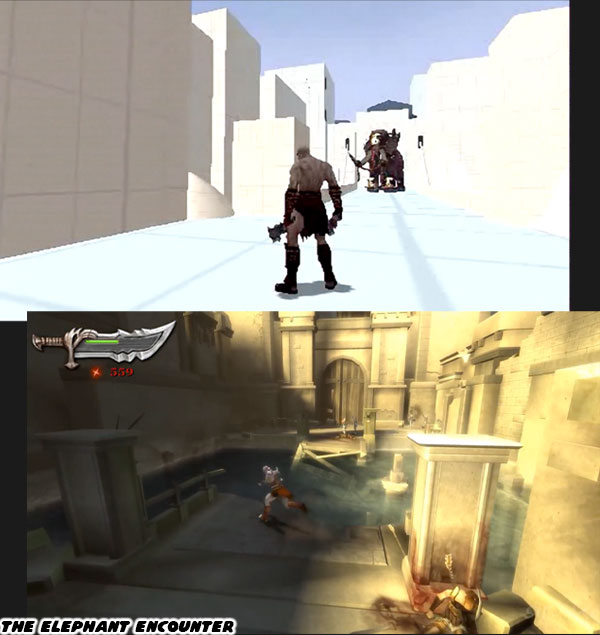
In the final version of the game Kratos is on one side of a moat, there is a collapsed bridge between him, and some Persian archers on the opposite side. They are taking shots at the future god of war. Remember during this timeline Kratos hasn’t killed Ares yet. He isn’t at full-power, nor reputation. I like to think that it was the elephant that destroyed this bridge in the finished version of Chains of Olympus. I only wish the studio had placed it at the bottom of the moat to complete the story. Anyhow I think that this encounter highlights the approach that Ready at Dawn had over the pacing of the game when compared to Sony Santa Monica. Up until this point the GoW series followed a familiar template. The games start in the middle of the action. A fight scene teaches the basic controls. These are usually against humans, or human-sized monsters. Then an enormous opponent is introduced. It might be the Hydra, the Colossus of Rhodes, the Scylla, or the Basilisk. The fight against these enormous creatures seems impossible, but is manageable with the strength of Kratos, his indescribable toughness, and the magical Blades of Chaos. The rest of the game is a series of smaller encounters until a mid, or final boss is reached. The games would recycle the same characters again, and again throughout the quest. Sometimes they would be reskinned, were still cool looking, but essentially the same rivals. The lack of unique opponents was something that I would consider the only weakness to the GoW franchise.
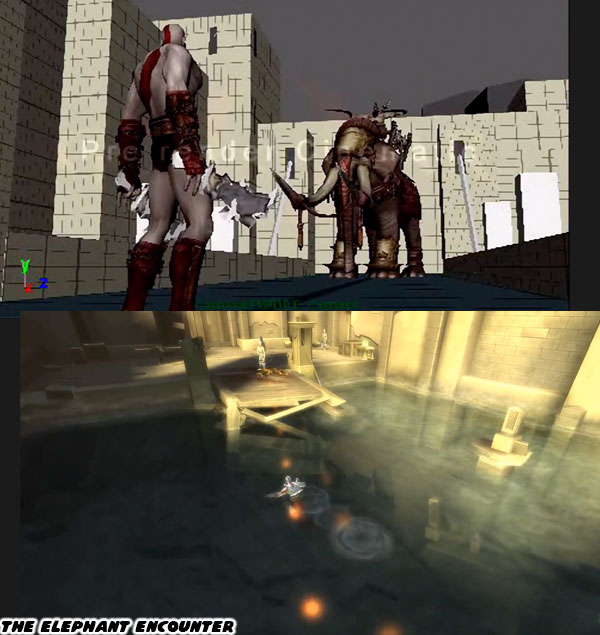
Ready at Dawn wanted to break the cycle by introducing sub-bosses that were tailor-made to the game. They weren’t as enormous as the final bosses, but more grounded in reality. We’ve seen Kratos take on mountain-sized opponents, and while those fights are fun, we sometimes forget how amazing he is in close combat. That is why the developers had him take on the kings of the jungle. Fighting supernatural lions, boars, bulls, and serpents are the types of challenges that Hercules, Theseus, Jason, and Perseus conquered in their classic adventures. At the same time the creatures in the Chains of Olympus are more than typical wild animals. The Piraeus Lion is bigger than any horse. It is covered in arrows, and swords, showing that it is impervious to most weapons. While the War Elephant is armored, has blades on his tusks, and is trained to fight. To raise the stakes the encounters are set in a tight space. Ready at Dawn knew that they were delivering something memorable. These fights served the story. They helped develop the character of Kratos, and fleshed out the fantastic world he lived in.
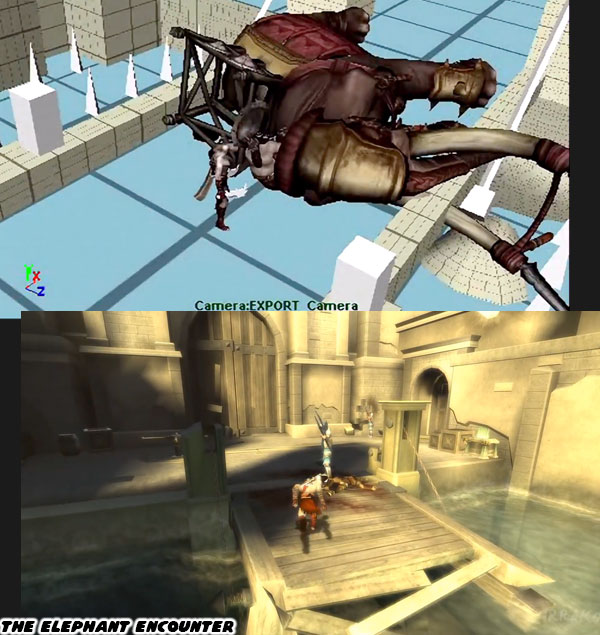
The studio was still able to create a memorable stage despite having to make cuts in the final version of the game. On the back of the Elephant was a Persian King. He undoubtedly taunted Kratos at the gates of Attica, just as he did in the final version. This character was massive. He was as big as Alric, the Barbarian King that almost killed Kratos in God of War, and had returned for a rematch in God of War II. The Persian King was going to be every bit Alric’s equal, and then more. He was on an elephant after all, which was much bigger than a draft horse. He also fought with a gigantic scimitar instead of a hammer, giving him a lethal reach advantage. He could even summon an Efreet, a sort of fire demon to create a burning ring around him. Alric did not gain magical attacks until he was already dead. On his back the Persian carried golden spears. Although he doesn’t use them in the game I have a feeling these would have been his ranged attacks against Kratos. He could have easily struck the Ghost of Sparta from across the stage thanks to his high perch.
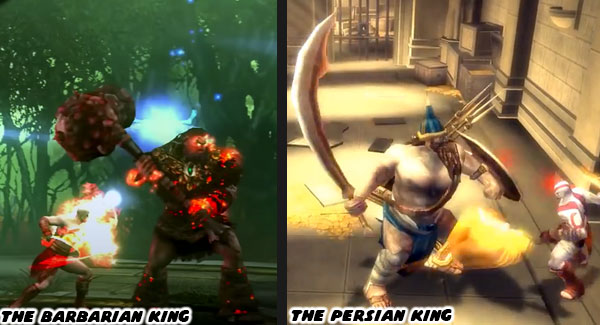
The final version of the battle had the Persian taunting some slave girls when Kratos shows up. He says the Spartan is nothing but a messenger for some puny gods. This is of course raises the ire of Kratos. Traditional Persian soldiers surround, and attack him while the king hacks away. It’s a fun battle, and I can almost imagine that the War Elephant would have been a two-part fight. Kratos would have to find a sweet spot to fight on the bridge. If too close then the elephant could have swiped him with his tusks, thrown him to the ground with his trunk, or trampled him with his feet. If Kratos were too far then the king could have rained spears down on him. Once the elephant was defeated then I bet the king would have fallen back, and entered the slave girl room.
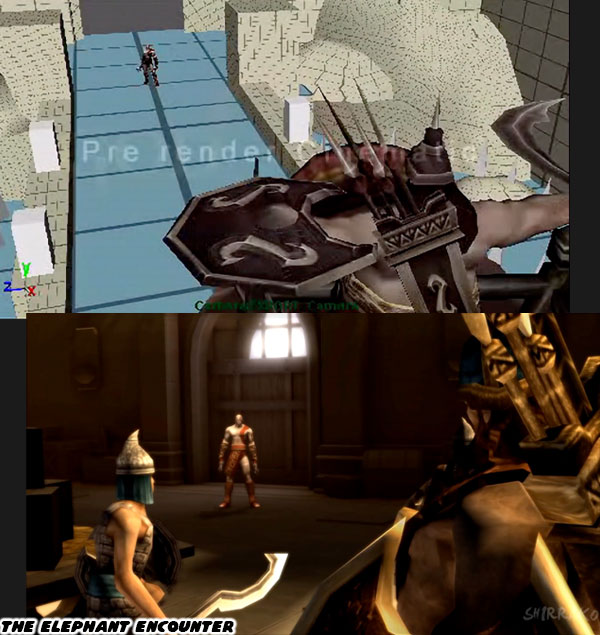
While large, and strong the King shares something in common with the Dissenter from Ghost of Sparta. They are both bullies when they think they are winning. Despite talking big they instantly change their tune once Kratos has them beat. The Dissenter called Kratos an impostor, and that Ares was the true god of war while Kratos is getting pounced on by the lion. The King mocks Kratos when they first meet, but then tries to bribe Kratos when he is knocked down. He offers him gold, and women. Kratos turns down the bribe, and then bashes a gold chest over his face. The brutal ending of the king was as satisfying as it was to the Dissenter. I have a feeling that the same person at Ready at Down had scripted both encounters.
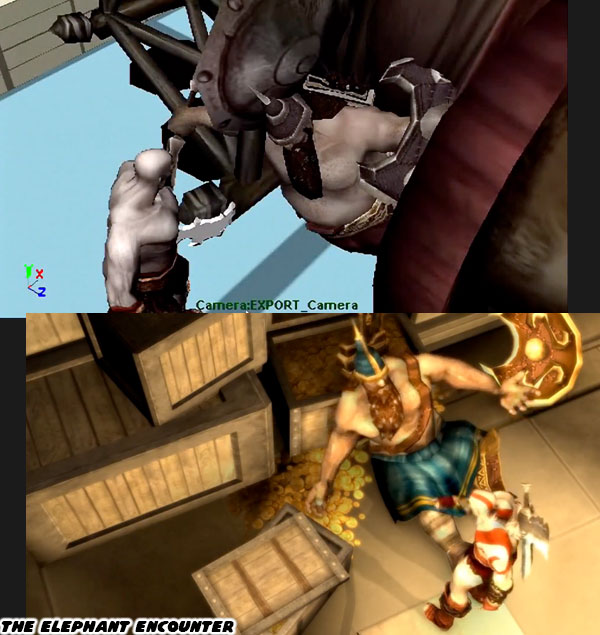
If I had any programming, or modeling experience I’d love to restore this battle the way it was originally meant to be seen. Even if just to watch Kratos get thrown around by an elephant for a minute. I’m grateful that the artists shared their work online, and that Sony also posted additional content. So many game studios never publish art books, or share their concept work. It will hopefully inspire future designers to push the boundaries of their own art, and think about how to plot out a game, or story. I’d like to know if there was a concept character, or stage from God of War, or any other game that you wish had made it into production. Let me know in the comments section please. As always if you would like to sponsor me
please visit my Patreon page and consider donating each month, even as little as $1 would help make better blogs and even podcasts!














No comments:
Post a Comment